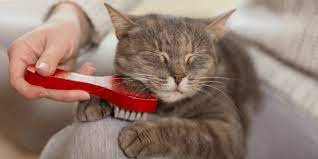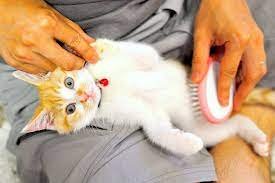
Blog
Asking For A Fur-Friend
Why Is Brushing Your Cat Important?
Just as we, as humans, brush our hair, our cat’s hair may need the same attention. There are health benefits for your feline friend by making sure we are keeping up with their grooming. A clean cat is a happy cat, from nail trims to bathing, a little maintenance goes a long way.
Just as we, as humans, brush our hair, our cat’s hair may need the same attention. There are health benefits for your feline friend by making sure we are keeping up with their grooming. A clean cat is a happy cat, from nail trims to bathing, a little maintenance goes a long way.
Brushing your cat not only removes dirt, grease and dead hair from their coat, but it also helps to remove skin flakes and stimulates circulation. Brushing your cat a few times per week will help your cat to keep their healthy glow and soft coat. Regular brushing sessions are especially important and beneficial when your cat gets older and is no longer able to groom themselves.
Brushing your cat comes with a ton of benefits for both you and your cat. This can be a great bonding time for you and your kitty; the time spent together can grow the bond you already have. Please note, not all cats enjoy grooming and if your cat fights you in the process and there is risk of injury to you or your cat, consider taking your cat to a groomer or your veterinarian for grooming.
Fewer hairballs. Hairballs can be a normal part of having a cat. However, they can be super gross to step in and clean up. The more you brush your cat and help them remove excess hair, the less likely you are to find hairballs.
Less shedding. Brushing your cat on a regular basis can reduce the amount of excess hair your cat carries throughout your home.
Flea spotting. Even indoor cats can get fleas so regular brushing can help you spot fleas as soon as possible. I encourage you to make sure all animals in your home are on a veterinarian recommended flea prevention.
Pain-free grooming. If you have an older cat or a cat who suffers from arthritis or mobility issues that may make self-grooming difficult, your help with their grooming I am sure would be welcomed.
Better bonding. If you have more than one cat, you may have noticed that they groom each other. Cats do this as a way to build trust and of course show affection. Like I mentioned earlier, brushing your cat can help build the bond between you and your pet.
So, now that we have discussed the benefits to brushing your cat, let’s talk about equipment. There are many different types of brushes when you walk down the grooming aisle at the pet store. It can be overwhelming if you are unsure of where to begin. For most cats, using a bristle brush or pin brush will work just fine. You can use the pin brushes to work out mats and tangles, while the bristle brush is great for a good brushing that will remove excess hair from your feline friend. For long hair cats, you may need to try a flea comb or moulting comb. These look much more like a human comb with wider teeth. These combs can get into the fur of most fluffy felines. If your cat is sensitive to brushes or just downright does not like them, a grooming mitt is a great alternative.
Now we will dive into some best practices for grooming your kitty. If your cat is not already accustomed to a regular grooming routine, these tips are a great jumping off point to get you and your cat into a routine.
Get comfy. To begin, make sure your cat is comfortable and receptive to being touched. It is always good to give your cat a few pets to make sure they are not ‘in a mood’.
Move slowly. Begin with gentle strokes with the brush or comb. Start brushing the areas where your cat likes to be pet, which is typically on their back, between their ears or under their chin.
Venture farther. As your cat becomes comfortable with the feel of being brushed, you can slowly make your way towards brushing more sensitive areas such as the belly. If your cat decides to bite or attack the brush, move back to a spot your cat is more comfortable with before forcing your cat to a brushing in their ‘no fly zones’.
Reward. Every grooming session should end with a treat or some play. Your cat will begin to associate being brushed with receiving a reward, making it a positive experience for you and your pet.
Grooming neglect can lead to mats that can pull on delicate skin or even make it difficult for your cat to walk. Dense mats on your cat can block air flow to the skin and cause irritations and your cat may chew on the mat due to pain and end up ripping their skin.
If you brush your cat on a regular basis, the daily maintenance should not take very long. Grooming shouldn’t be torture and should not last even 30 minutes. With longhaired cats, brushing a few minutes each day will keep their coat in good condition. For shorthaired cats, brushing a few times a week will suffice.



